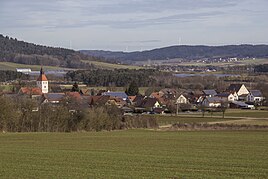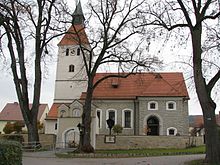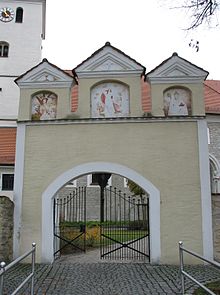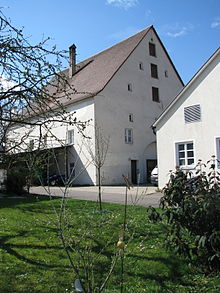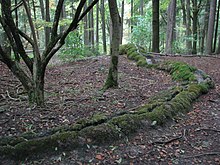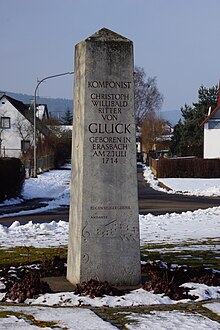Erasbach
|
Erasbach
City of Berching
Coordinates: 49 ° 8 ′ 45 ″ N , 11 ° 25 ′ 14 ″ E
|
|
|---|---|
| Height : | 406 m |
| Residents : | 540 (2016) |
| Incorporation : | May 1, 1978 |
| Postal code : | 92334 |
| Area code : | 08462 |
|
Erasbach
|
|
Erasbach is a district of the city of Berching in the Neumarkt district in the Upper Palatinate in the Upper Palatinate administrative region .
location
The church village is located at around 406 meters above sea level in the plain south of the curve that the Main-Danube Canal makes from Berching to Hilpoltstein , north of a ridge that rises with the Röschberg up to 564 meters above sea level.
history
Erasbach was first mentioned in a document as "Erichesbach" on July 22nd, 1080, when King Heinrich IV of Nuremberg granted Bishop Odalrich von Eichstätt the privilege of exercising wild bans in a clearly defined area north of Eichstätt. Erichespach was a border town in this wilderness area. The settlement was originally a Reichsministerialesitz, as a document from the 12th century says; these Reich ministerials also became ministerials of the Eichstätter Church. Between 1138 and 1149, a Merbort de Erichspach worked as a documentary witness for Bishop Gebhard II . Around 1140 a Reginger de Eringespach or Erichespach appears as a witness in documents from the Weihenstephan monastery. A few decades later, between 1183 and 1195, the Eichstatt Bishop Otto consecrated a church in "Erinsbach". In 1223 one learns of an "ecclesiasticus", ie sacristan , named Volcmar von Erichesbach. Later there was a transfer to the Counts of Hirschberg , because in 1305, when the Counts of Hirschberg died out, "Erispach" with "People, Goods and Court" in the Gaimersheimer Spruch was awarded to the Bishop of Eichstätt. Around 1326/29 Luitpold and Albert von Wolfstein zu Niedersulzbürg handed over two possessions at Erasbach and Pollanten , which they probably had from the Eichstätter church, to the Plankstetten monastery on the exchange route ; In 1329 the monastery acquired a forest near Erasbach from Heinrich Ziegenfelder. The Plankstetten monastery received another farm in Easbach in 1376 from the foundation of the branch monastery "Klösterlein Grab" on Schlüpfelberg from the Lords of (Hilpolt-) Stein from their own property. The Wolfsteiner had further possessions in Erasbach, because in 1359 the Wolfsteiner Erasbach Albrecht the Elder of Wolfstein zu Pyrbaum was awarded in a partition contract . In 1436 the Wolfsteiners acquired a court at Erasbach from the property of those at court; In 1740 15 subjects of their allodial heirs came from Erasbach. When in 1769 the Bavarian elector acquired the Wolfstein allod property from the allodial heirs of the Wolfsteiners, the princes of Hohenlohe and Giech , property in Erasbach was among them with around ten estates. Three possessions of the bishop of Eichstätt were under the episcopal caste office Jettenhofen of the lower bishopric .
Since 1346 the noble family of the Koppen sat at the castle of Erasbach. From these the property came to Konrad Hillebrand in 1375 and from him to Nikolaus Hillebrand in 1396. After that, the country estate was owned by the Mühlbecks, whose sandstone coat of arms has been preserved in the church. Later owners were Reichhart von Bechthal (1519), the keeper of Helfenberg Hans Thanhauser (from 1522), Christoph von Eyb (1544), Friedrich von Lichtenau (1556), Ulrich Dieß (1568), doctor of rights Georg Hofmann (1573), Christian Hartung (1586), again Georg Hofmann (1591), Georg Deublinger / Deiblimger (1601), the Neumarkt city pastor Mathias Faber (1630), with his entry into the Jesuit order the Jesuit college in Eichstätt (1630), the nurse of Velden , the Nuremberg's Christoph Ludwig Gugel (1651), the caretaker of Pfaffenhofen-Haimburg Karl Tuntzler (1697), Karl Tunzler's heirs (1707), finally that of Ruprecht (1710 until the 19th century; Brother Michael Joseph von Ruprecht died in Amberg in 1829) . Their seat was a pond south of the church, which has been preserved. For 1644, the Hofmark Erasbach has small property in Landerzhofen and Kevenhüll . From 1732 there was a second country estate in Erasbach, a court of Egidius von Vallende with two landholders, which passed through his widow to her second husband, Jakob de Lonley, and was bought again in 1806 by Freiherr von Ruprecht zu Erasbach. Now, towards the end of the Old Kingdom , Erasbach consisted of 55 properties that were subject to the Kurbaierisches Schultheißenamt Neumarkt.
In the new Kingdom of Bavaria (1806) the Hofmark Erasbach was granted second class patrimonial jurisdiction under Baron Joseph von Ruprecht . These included 22 court inmates in Erasbach, four in Weihersdorf and one each in Bachhausen , Großberghausen and Kevenhüll; it was repealed after the baron voluntarily renounced a local court in September 1815, and the court seats were assigned to the royal district court Neumarkt . In 1827 they were assigned to the district court and rent office of Beilngries with the Erasbach tax district (= Erasbach, Bachhausen and Weidenwang), which had existed since 1808, or with the Erasbach rural community formed in 1818 , which had consisted of Erasbach and Weidenwang from 1811 until then . From 1827 to 1830 the rice mill belonged to the municipality of Erasbach.
As of January 10, 1873, there were 64 “cattle holdings” in Erasbach with a total of 22 horses, 242 head of cattle, 232 sheep, 76 pigs and six goats. In 1873 the schoolhouse, "200 paces" from the church, was rebuilt; the teacher was at the same time cantor, organist and sacristan. In 1900 the livestock was 14 horses, 251 head of cattle, 120 sheep, 192 pigs and 24 goats.
In the Third Reich there was a military training camp for the Hitler Youth in Erasbach , which was used as a camp for displaced persons in the first post-war years .
In the course of the Bavarian regional reform , Erasbach joined the town of Berching in the Neumarkt id Opf district late in 1976 with its approximately 516 hectare area. In 1979 a new cemetery was opened.
Population development
- 1795: 131 (3 courtyards, 27 houses)
- 1818: 160 (27 houses)
- 1830: 330 (63 houses and the upper mill)
- 1873: 346 (70 houses, 84 families)
- 1900: 307 (65 residential buildings)
- 1950: 686 (74 properties)
- 1961: 335 (72 residential buildings)
- 1987: 436 (127 residential buildings, 150 apartments)
- 2016: 540
Curate Church of the Visitation of the Virgin Mary
The first church consecration took place between 1183 and 1195 by the Eichstatt Bishop Otto . The current church dates from the 14th century Gothic, but was changed in the 18th century and restored in 1873. As unplastered parts of the wall show, it is built from small, fairly regular blocks of limestone . The two-column high altar is considered an "original work of the 17th century". The side altars date from around 1725. In the tower hang two larger cast steel bells from the 1920s and a smaller, older bronze bell. - The Erasbach Curate is now part of the Berching Parish Association of the Eichstätt diocese .
Architectural monuments
In addition to the church, the property at Am Erlenbach 10, the former country estate as a pond house, a two-story saddle roof building in need of renovation from the 16th century, and the former Zehentstadel in Zehentstraße 4 (in the east of the village), a two-story saddle roof building from the 17th century, are considered architectural monuments Century.
See monuments in Erasbach .
Natural monument Steinerne Rinne
This is a limestone trough that has been created over the years by the precipitation of lime from the water of the small stream that flows through the channel.
traffic
The place is on the state road 2237, from which branch-off north-west of Erasbach local connecting roads to the neighboring villages Weidenwang and Bachhausen.
societies
- Erasbach volunteer fire brigade, founded in 1875
- Fruit and horticultural association
- Warrior Association (SRK), founded in 1920, re-established in 1954
- Ball-Spiel-Verein (BSV) Erasbach, founded in 1930, re-founded in 1959
- Zimmerstutzen shooting club, founded in 1911
- Catholic Workers' Movement (KAB) Erasbach, founded in 1964
- Erasbach women's group, founded in 1984
Personalities
- Christoph Willibald Gluck , composer, opera reformer, born July 2, 1714 in Erasbach (disputed with Weidenwang), see, † November 15, 1787 in Vienna
- Johann Koller, painter and sculptor, * 1838 in Erasbach, † 1920 in Neumarkt in the Upper Palatinate
- Anton Kolb, Dr. rer. nat., Professor of Biology in Bamberg, bat researcher , born November 5, 1915 in Erasbach, † April 20, 1998 in Erlangen
literature
- Franz Heidingsfelder (arr.): The Regesta of the Bishops of Eichstätt , Erlangen: Palm & Enke 1938
- Gerhard Hirschmann: Historical Atlas of Bavaria, Part Franconia, Series I, Issue 6: Eichstätt, Beilngries-Eichstätt-Greding. Munich 1959
- Bernhard Heinloth: Historical Atlas of Bavaria, Part of Old Bavaria, Issue 16: Neumarkt, Munich 1967
- Friedrich Hermann Hofmann a. Felix Mader: The art monuments of Upper Palatinate & Regensburg. XII. District Office Beilngries. I. District Court of Beilngries , Munich 1908
- Alfons Baier: The "stone channel" on the mountain south of Erasbach / Opf. - an investigation into the hydrogeology and chemistry of the Shallow Karst. In: Geol. Bl. NO-Bayern 52, 1–4, pp. 139–194, Erlangen 2002, see [2]
Web links
- Bells of the church of Erasbach
- Local history on private website
- Erasbach in the location database of the Bavarian State Library Online . Bavarian State Library, accessed on August 27, 2020.
Individual evidence
- ↑ Heidingsfelder, p. 87 f. (No. 259); Hirschmann, p. 22
- ↑ Heinloth, p. 36
- ↑ Heidingsfelder, p. 119 (No. 380)
- ↑ Heinloth, p. 37
- ^ JB Fuchs: The consecrations of Bishop Otto zu Eichstätt in the years 1183–1195 . In: 25th annual report of the historical association in Middle Franconia , Ansbach 1857, Appendix I, p. 6
- ↑ Heidingsfelder, p. 189 (No. 605)
- ↑ Heidingsfelder, p. 418 (No. 1346) Heinloth, p. 32
- ↑ JB Fuchs: History of the former. Benedictine monastery Plankstetten in the diocese of Eichstätt , in: 16th annual report of the historical association in Middle Franconia , Ansbach 1847, p. 41 ff., Especially p. 59; Heinloth, p. 167 f.
- ↑ Heinloth, pp. 98, 107
- ↑ Heinloth, p. 106 f.
- ↑ Hirschmann, p. 78
- ↑ Hofmann / Mader, p. 63; Heinloth, p. 179 f.
- ^ Felix Mader: History of the castle and upper office Hirschberg. Eichstätt 1940, p. 86
- ↑ Heinloth, p. 180
- ↑ Heinloth, p. 259
- ^ Royal Bavarian Intelligence Gazette for the Upper Danube District , Eichstätt, September 16, 1815, Col. 760 f.
- ↑ Franz Kumpf: Legal statistics of Middle Franconia and the courts separated from the former Rezatkreise , Ansbach 1839, p. 19, footnote g; Hirschmann, p. 213
- ↑ Georg Mayr (edit.): The cattle count in the Kingdom of Bavaria from January 10, 1873 , Munich 1874, p. 76
- ↑ Valentin Grübel (edit.): Statistics of the German schools in the district of Middle Franconia , Ansbach 1873, p. 330
- ^ Locations directory of the Kingdom of Bavaria with an alphabetical register of locations , Munich 1904, column 807
- ↑ Hans Holzträger: The military training camps of the Hitler Youth, 1942–1945. A documentary report, Ippesheim 1991, pp. 104, 109
- ↑ Information on the Berching website
- ^ Erasbach on the Berching website
- ↑ Geographisches Statistisch-Topographisches Lexikon von Baiern , 1. Vol. (A – I), Ulm 1796, Sp. 563
- ↑ Johann Friedrich Jacobi: New systematic and general description of the earth of the Bavarian royal state , Volume IV, Augsburg 1818, p. 105
- ^ Karl Fr. Hohn: The rain district of the Kingdom of Bavaria, geographically and statistically described. Stuttgart and Tübingen 1830, p. 138
- ↑ Grübel, p. 330
- ↑ K. Bayer. Statistical Bureau (Hg): Directory of localities of the Kingdom of Bavaria with an alphabetical register of places [based on the census of December 1, 1900]. Munich 1904, column 807
- ↑ Hirschmann, p. 212
- ^ Official register of places for Bavaria. Territorial status on October 1, 1964 with statistical information from the 1961 census , Munich 1964, column 517
- ↑ Official directory for Bavaria, territorial status: May 25, 1987 , Munich 1991, p. 256
- ^ Website of the city of Berching
- ↑ Heidingsfelder, p. 161 (No. 501)
- ↑ Hofmann / Mader, p. 62
- ^ Sixtus Lampl: Monuments in Bavaria - ensembles, architectural monuments, archaeological site monuments : Volume III: Oberpfalz , Munich 1985, p. 133
- ↑ Alfons Baier: "The stone channel" on the mountain south of Erasbach / Opf. An investigation into the hydrogeology and chemistry of the Shallow Karst. In: Geological sheets for northeast Bavaria and neighboring areas. (= Geological sheets for northeast Bavaria and adjacent areas. Volume 52). Erlangen 2002, pp. 139-194. ( online )
- ↑ [1]
